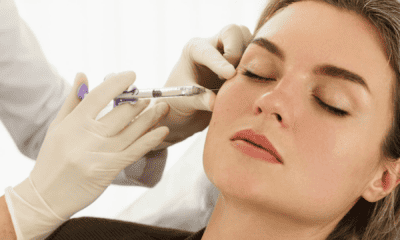Are people today paying more attention to their jawline? The answer among our panel of experts is a resounding, “Yes! Younger and younger patients are coming in concerned about sagging skin or jowling in the lower face, hoping to find a quick answer.
In the latest PSC Roundtable, Dr. Bruce Van Natta of Indianapolis discusses this emerging trend with his colleagues Dr. John Q. Cook of Chicago, Dr. Ned Snyder of Austin and Dr. Steven Camp of Fort Worth. What is causing this infatuation with the neck/chin juncture? And what are some of the treatment options available today for addressing this problem area?
Are Patients More Focused on the Jawline?
Patients today, particularly younger patients, are definitely more focused on the jawline than ever before. “If you look ten years ago, I don’t think I saw people in their late 30’s and early 40’s coming in and asking about the earliest signs of jowling,” says Dr. Snyder.
Jowling is typically defined as a looseness in the skin and tissues in the lower part of the face. The result is sagging, drapes of skin around the outside of the mouth, and a lack of definition or crispness along the jawline. It’s definitely something that young people are more aware of and concerned about than they were in the past.
Options for Treating the Jawline
One of the hallmarks of plastic surgery is innovation. Surgeons are constantly listening to their patients and coming up with new and better methods for addressing their needs. The mainstay for addressing a “weak” jawline, classically, “has been a surgical chin implant,” explains Dr. Camp.
Augmenting the chin creates more definition, but younger patients are really more concerned with defining what they call the edge of the jawline. And they don’t necessarily want to resort to surgery. Injectables can be used to some effect, depending entirely on each unique situations. Some of these include:
- Botox
- Dermal fillers
- Kybella
These can be used in tandem or alone and offer results with little to no downtime.
Diagnosis is Key
The right procedure is always going to depend on making an accurate diagnosis. This is why it is crucial that a patient book a consultation to be assessed in person by the plastic surgeon. A procedure will only work if it is the right one for a patient’s individual anatomy and needs.
In terms of the jawline, “[if the patient] has some early loss of tone in the jaw, we usually use external radiofrequency (RF),” explains Dr. Cook. This non-invasive procedure can be very effective at promoting the body to produce more collagen and elastin. As collagen acts like the support beams for the skin and elastin is responsible for skin’s ability to “bounce back” after a smile or frown, skin with more of these two is naturally more lifted, smooth and youthful looking.
Minimally Invasive RF & Neck Lift
External RF, however, is best for patients with just a mild degree of laxity. For those who are in the middle with more severe looseness, Dr. Cook will use a minimally-invasive RF procedure, such as FaceTite or BodyTite. With this procedure, the plastic surgeon makes a couple of very tiny incisions in the treatment area through which a probe is passed. One part of the probe glides along the top of the skin while the other travels below the surface of the skin. The RF energy passes between the two ends of the probe, heating both the surface of the skin and the deeper dermis for a more dramatic improvement and lift.
But once the laxity in the low face gets to a certain point, nothing is going to beat a neck and jaw lift, “because you are working in 3 dimensions,” explains Dr. Cook. It all comes down to matching the proper procedure to the patient. If you try to use one of the lesser techniques on someone who has a real problem, it’s not going to work.”
Selfies Driving Jawline Obsession
“Is this new interest in the jawline coming from Social Media?” asks Dr. Van Natta. Dr. Snyder believes that it is absolutely being driven by selfies and modern technology. “It’s people taking pictures of themselves and posting close ups,” he shares.
They look at these photos all day, and are paying closer attention to themselves, their own perceived defects and the early signs of aging. Furthermore, people are capturing pictures of themselves in everyday activities “that aren’t necessarily flattering,” adds Dr. Camp. A couple of years ago, he kept hearing the term “tech neck.” It described the situation in which patients would look down at themselves on their phones and catch a picture of themselves from the reverse view. “This view is the most unflattering view that you can have of yourself,” he explains.
It’s also not realistic. Dr. Camp believes that it is the job of the plastic surgeon “to refocus our patients and make sure that they are grounded in what they’re seeing.”






















Facebook
Twitter
Instagram
YouTube
RSS